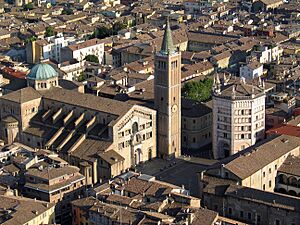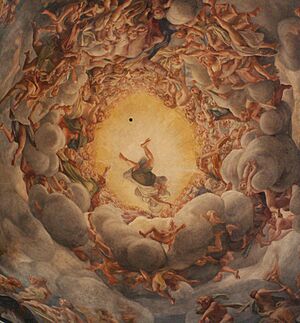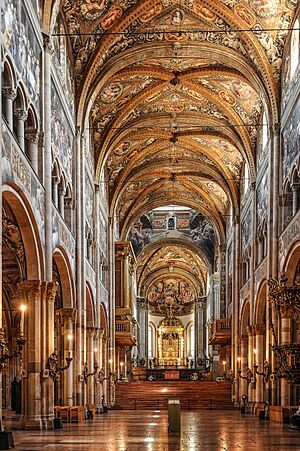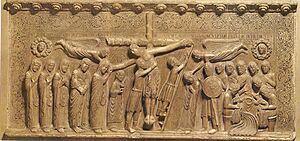Parma Cathedral facts for kids
Parma Cathedral is a very old and important church in the city of Parma, Italy. It's also known as the Duomo di Parma. This big church is dedicated to the Virgin Mary. It's the main church for the local bishop.
The cathedral is famous for its amazing Romanesque style. This means it was built in a style popular in Europe around 1000-1200 AD. Its dome has a super cool 3D-like painting by a famous artist named Antonio da Correggio.
Contents
History of Parma Cathedral
Building the First Churches
People think there might have been a church here as early as the 500s. But that church was later left empty. Then, in the 800s, another church was built behind the first one.
A New Beginning After a Fire
In August 1058, a big fire destroyed the old church. So, a new cathedral was started in a different spot. This new building was officially opened in 1106.
Earthquake and Repairs
Sadly, a strong earthquake hit in 1117. It damaged the new church a lot, so it needed many repairs. Today, you can still see parts of the original building. These include sections in the main altar area, the side parts of the cross-shaped church, and some old sculptures.
Architecture of Parma Cathedral
The Grand Front of the Cathedral
The wide front of the cathedral is made from sandstone blocks. It was finished in 1178. It has three levels of open arches, called loggias. There are also three main doors. The wooden doors were carved in 1494.
Two large marble lions hold up the arches above the main door. These lions were carved in 1281. Between the middle and right doors, you can find the tomb of a mathematician named Biagio Pelacani. He passed away in 1416.
The Tall Bell Tower
The tall, pointed bell tower was added later, between 1284 and 1294. It has a shiny copper angel on top. There were plans to build a second, matching tower on the left side, but it was never started. Right next to the cathedral is the Baptistery of Parma, a cool eight-sided building.
Inside Parma Cathedral
Layout and Decorations
The inside of the cathedral looks like a Latin cross from above. It has a main aisle and two side aisles. These are separated by large pillars. The area around the main altar and the side sections are raised. This is because there's a crypt, or underground room, underneath.
The tops of the pillars, called capitals, are very special. Many of them have detailed carvings. These carvings show leaves, mythical creatures, battle scenes, and stories from the Bible.
Amazing Paintings
The walls of the main aisle and the altar area are covered with frescoes. These are paintings done on wet plaster. They were created by artists like Lattanzio Gambara and Bernardino Gatti. Along the main aisle, you can see paintings of Old Testament stories. There are also scenes about the life of Jesus.
The most famous painting is on the dome. It's called Assumption of the Virgin. The artist Correggio painted it between 1526 and 1530. It looks so real, like the figures are floating up into the sky!
Sculptures and Chapels
A red marble staircase leads up to the side sections of the church. In the right side section, you'll find a famous stone carving called the Deposition. It was made by Benedetto Antelami in 1178. This carving shows Jesus being taken down from the cross. It used to be part of the church's pulpit, where sermons were given.
The side chapels were built for important families from Parma. Two of them, the Valeri Chapel and the Commune Chapel, still have their original decorations from the 1300s. The Valeri Chapel has frescoes from the 1400s. The frescoes in the Commune Chapel were painted after a terrible plague in 1410–11. They are dedicated to Saint Sebastian.
The Crypt Below
The crypt is an underground area. It has pieces of old mosaics. These show that a temple might have been here as far back as the 200s or 300s AD. The crypt also has a monument to Saint Bernardo di Uberti. He was the bishop of Parma from 1106 to 1133.
Images for kids
See also
- History of medieval Arabic and Western European domes








